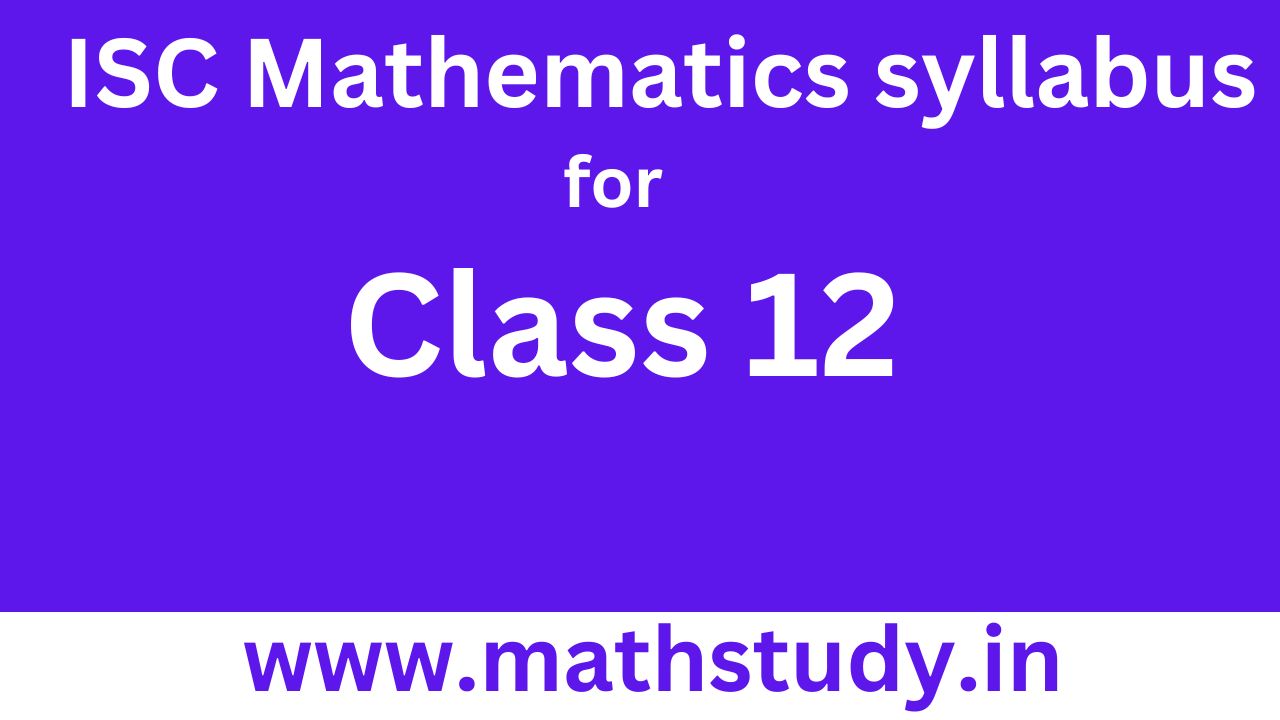
| Unit | Description | Marks |
|---|---|---|
| Relations and Functions | This unit lays the groundwork for understanding the fundamental aspects of relations and functions. It covers essential topics like domain, range, inverse functions, composite functions, and the basics of matrices and determinants. | 10 |
| Algebra | Algebra forms the core of mathematical problem-solving. This unit explores complex numbers, quadratic equations, matrices, permutations and combinations, the binomial theorem, and mathematical induction. | 10 |
| Calculus | As a cornerstone of the ISC Mathematics syllabus, Calculus is divided into Differential and Integral Calculus. It encompasses limits, continuity, derivatives, integration, and their applications. | 32 |
| Probability | This unit introduces students to the fundamental concepts of probability, including the rules of addition and multiplication, conditional probability, Bayes’ theorem, and random variables, with applications to real-life situations. | 13 |
| Vectors and Three-Dimensional Geometry | Focusing on the spatial aspects of mathematics, this section covers vectors, scalar and vector products, and three-dimensional geometry. | 11 |
| Linear Programming | Linear Programming introduces optimization techniques, covering the graphical method, simplex method, and duality theorem, with practical applications in solving real-world problems. | 4 |
| Application of Calculus and Additional Topics | This includes the practical applications of calculus in various fields, an introduction to differential equations, and a brief overview of coordinate geometry and conic sections. | 10 |
The ISC Mathematics syllabus for Class 12 in the year 2024 is meticulously structured into two main parts, encompassing a wide array of topics aimed at providing a comprehensive learning experience. This curriculum is designed to challenge students and deepen their understanding of mathematical concepts, preparing them for further education and various professional fields. Here’s a detailed exploration of the syllabus, including the distribution of marks across different sections and units.
The ISC Mathematics syllabus is strategically divided to cover foundational and advanced topics across three sections, with a total of 80 marks. – Section A (65 Marks) focuses on core mathematical principles and includes units on Relations and Functions, Algebra, Calculus, and Probability. – Section B (15 Marks) delves into applied mathematics, covering Vectors, Three-Dimensional Geometry, and the Application of Integral. – Section C (15 Marks) introduces practical applications of calculus, including Linear Regression and Linear Programming.
First House | Second House | Third House | Fourth House | Fifth House | Sixth House | Seventh House | Eighth House| Ninth House | Tenth House | Eleventh House | Twelfth House
All Nakshatras :
Ashwini Nakshatra | Bharani Nakshatra | Krittika Nakshatra | Rohini Nakshatra | Mrigashira Nakshatra | Ardra Nakshatra | Punarvasu Nakshatra | Pushya Nakshatra | Ashlesha Nakshatra | Magha Nakshatra | Purva Phalguni Nakshatra | Uttara Phalguni Nakshatra | Hasta Nakshatra | Chitra Nakshatra | Swati Nakshatra | Vishakha Nakshatra | Anuradha Nakshatra | Jyeshtha Nakshatra | Mula Nakshatra | Purva Ashadha Nakshatra | Uttara Ashadha Nakshatra | Shravana Nakshatra | Dhanishta Nakshatra | Shatabhisha Nakshatra | Purva Bhadrapada Nakshatra | Uttara Bhadrapada Nakshatra | Revati Nakshatra
Our E-Books on Astrology :
Facts about Saturn in Astrology
Our E-Books on Mathematics :
Word Problems for Grade 4 Students
Addition word Problems for Grade 3 Students
Addition Worksheets for Grade 1 Students
Math Workbook for Grade 1 Students
CAT Mathematics Practice Papers
Chapterwise Test Papers for Grade 12 CBSE & ISC Board Students
Class 12 Mathematics NCERT Solution Book
DPP For JEE Mains & Advance – Trigonometry
Division Word Problems for Grade 4 Students
HOTS & Important Questions for Class 12 Students CBSE & ISC Board
DPP For JEE Mains & Advance – Complex Numbers
Mathematics Workbook for Class 12 Students (Fully Solved )
Mathematics Formula Book for Class XI, XII, JEE & Other Competition Exam
The ISC Class 12 Mathematics syllabus for 2024 is divided into three main sections: Section A covers Relations and Functions, Algebra, Calculus, and Probability. Section B includes Vectors, Three-Dimensional Geometry, and the Application of Integral. Lastly, Section C focuses on the Application of Calculus, Linear Regression, and Linear Programming.
Calculus is a significant part of the ISC Class 12 Mathematics syllabus, carrying a total of 32 marks out of the total 80 marks. It is divided into Differential Calculus and Integral Calculus, encompassing various topics such as limits, continuity, derivatives, integration, and their applications.
The syllabus provided here is a broad overview of the topics typically covered in the ISC Class 12 Mathematics curriculum. For any updates or changes, including new topics for the 2024 exams, it's crucial to refer to the official CISCE website or contact your school.
To prepare effectively for the Probability section, focus on understanding the fundamental concepts, such as the addition and multiplication rules, conditional probability, and Bayes' theorem. Practice solving various problems, including those that apply probability to real-life situations, and review past exam questions to familiarize yourself with the types of questions asked.
For Vectors and Three-Dimensional Geometry, begin by strengthening your understanding of basic concepts like vector operations, scalar and vector products, and the equations of planes and lines. Visualizing problems can be particularly helpful. Practice solving a wide range of problems and use diagrams to aid your understanding of spatial relationships.
Solving previous years' papers and sample papers is crucial for several reasons. It helps you get accustomed to the exam pattern, types of questions asked, and time management. Additionally, it allows you to identify your weak areas, improve your speed and accuracy, and build confidence.
Managing stress is vital for effective exam preparation. Stick to a well-structured study plan, practice mindfulness, discuss any doubts with your teachers or peers, ensure you're getting enough sleep, and maintain a healthy diet. Remember, it's okay to seek professional help if feeling overwhelmed.
Lorem Ipsum is simply dumy text of the printing typesetting industry lorem.
© 2023 Created with Royal Elementor Addons